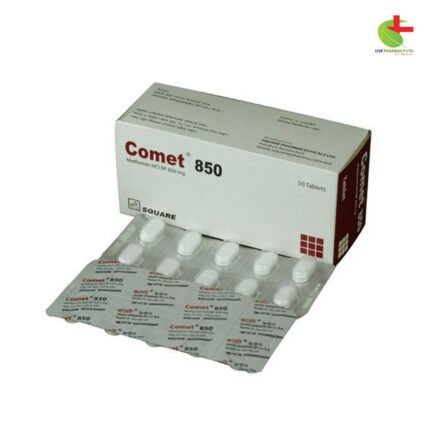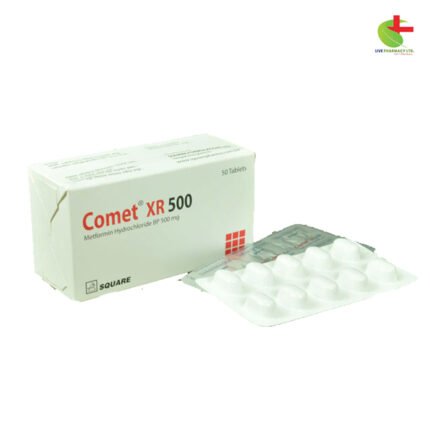Comet XR 1 gm
54.18৳ Strip
- Comet XR: Trusted medication for type 2 diabetes management
- Effective in overweight patients when lifestyle interventions aren’t sufficient
- Contains metformin, reducing both fasting and postprandial blood glucose levels
- Individualized dosages for personalized treatment
- Can be used alone or in combination with other antidiabetic agents or insulin
 Brand
Brand
|
Square Pharmaceuticals PLC |
|---|---|
 Generics
Generics
|
Metformin Hydrochloride |
Indications
Comet XR is indicated for the treatment of type 2 diabetes mellitus, particularly in overweight patients when dietary management and exercise alone do not achieve adequate glycemic control. In adults, Comet XR may be used as monotherapy or in combination with other oral antidiabetic agents or insulin. For children from 10 years of age and adolescents, Comet XR may be used as monotherapy or in combination with insulin. Metformin, the active ingredient in Comet XR, has shown a reduction in diabetic complications in overweight type 2 diabetic adult patients treated with metformin as first-line therapy after diet failure.
Pharmacology
Comet XR contains metformin, a biguanide type oral antihyperglycemic drug used in the management of type 2 diabetes. It reduces both basal and postprandial plasma glucose levels. Metformin’s mechanism of action differs from sulfonylureas, as it does not induce hypoglycemia. It works by decreasing hepatic glucose production, reducing intestinal absorption of glucose, and improving insulin sensitivity by increasing peripheral glucose uptake and utilization.
Dosage & Administration
The dosage of Metformin Hydrochloride in Comet XR should be individualized based on effectiveness and tolerance. Adults typically start with a dosage of 500 mg twice a day or 850 mg once a day, with meals. Dosage increases should be made in increments of 500 mg weekly or 850 mg every 2 weeks, up to a total of 2000 mg per day, given in divided doses. For those requiring additional glycemic control, Glucomin may be added, up to a maximum daily dose of 2550 mg per day. Children usually start with 500 mg twice a day, with dosage adjustments made weekly up to a maximum of 2000 mg per day.
Interaction
While there is limited information available about the interaction of Comet XR and Furosemide when co-administered chronically, Nifedipine appears to enhance the absorption of Comet XR. Comet XR had minimal effects on Nifedipine. Cationic drugs that are eliminated by renal tubular secretion may potentially interact with Comet XR by competing for common renal tubular transport systems.
Contraindications
Comet XR is contraindicated in individuals with hypersensitivity to the active substance or any of the excipients, acute metabolic acidosis (such as lactic acidosis, diabetic ketoacidosis), severe renal failure (GFR <30 mL/min), and acute conditions with the potential to alter renal function or cause tissue hypoxia.
Side Effects
Adverse effects of Comet XR may include gastrointestinal disorders, taste disturbance, lactic acidosis (rare), liver function test abnormalities or hepatitis (very rare), and skin reactions (very rare).
Pregnancy & Lactation
Uncontrolled diabetes during pregnancy is associated with an increased risk of congenital abnormalities and perinatal mortality. During pregnancy, it is recommended that diabetes is not treated with metformin but insulin be used to maintain blood glucose levels as close to normal as possible. Metformin is excreted into human breast milk, and breastfeeding is not recommended during metformin treatment due to limited data availability.
Precautions & Warnings
Comet XR is substantially excreted by the kidney, and the risk of accumulation and lactic acidosis increases with the degree of impairment of renal function. Regular monitoring of renal function is advised in all diabetics. Special caution is recommended in elderly patients and pediatric populations.
Use in Special Populations
Elderly patients and pediatric populations require dosage adjustments and close monitoring due to variations in renal function and growth considerations, respectively.
Overdose Effects
While hypoglycemia has not been seen with Comet XR doses up to 85 gm, lactic acidosis has occurred in such circumstances, necessitating immediate medical attention.
Therapeutic Class
Comet XR belongs to the class of biguanides, known for their antihyperglycemic properties.
Storage Conditions
Store Comet XR below 30°C, protected from light and moisture, and out of reach of children.













Reviews
There are no reviews yet.